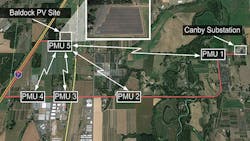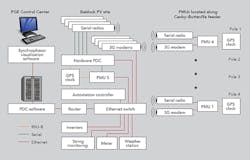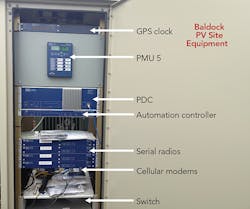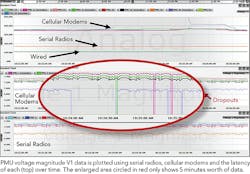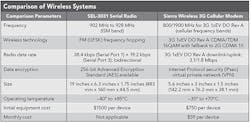PGE Evaluates Wireless Performance
Wireless communications offer many advantages to industries such as electric power and telecommunications. As the popularity of wireless communications continues to grow, evaluating all the available choices can be challenging.
A relatively new technology, synchronized phasor measurements, or synchrophasors, can provide valuable real-time measurements of electrical quantities to give a clear indication of the state of the power system. This is what Portland General Electric (PGE), Northern Plains Power Technologies, Schweitzer Engineering Laboratories (SEL) and Advanced Energy Industries Inc. found when they designed a synchrophasor system for evaluating the Canby–Butteville distribution feeder. Synchrophasors proved valuable not only for evaluating the rural feeder, but also for comparing the 3G cellular modems and 900-MHz serial radios.
To compare the performance of the cellular modems to serial radios, five phasor measurement units (PMUs) were set up on a rural feeder to stream simultaneously transmitted IEEE C37.118 synchrophasor measurement data, which were collected at 30 measurements per second and time-synchronized to 1 microsecond. This essentially provided a live test bed where the PMUs provided synchronized high-resolution parametric measurements of system frequency, voltage phasors and current phasors. The data was measured and archived continuously for one week.
Communications with Serial Radios
SEL assisted PGE with the upfront planning required of wireless communications systems to ensure a reliable communications link was established between PMUs. One of the first steps in choosing a wireless communications system is understanding the end-application requirements of that system. Typical requirements include latency, data bandwidth, distance and availability, to name a few. Conducting a path study should be the first step. The user enters the GPS coordinates of the radios, and the path study software estimates the wireless link performance based on known terrain data and physical structures.
The next step is a site survey, which is necessary to verify the terrain and identify obstructions, or any adjustments needed in radio and antenna placement. To ensure the best results, the site survey should include setting up temporary radios at the desired locations and include spectrum measurements to ensure there are no sources of interference.
The overall system uses a 900-MHz serial radio and a 3G cellular modem at each PMU along the feeder. Data was transmitted to a receiving radio and then to the phasor data concentrator (PDC) located at the photovoltaic (PV) site. A fifth PMU located at the PV site sent data through serial and Ethernet cables to the PDC. Data from all five PMUs was concentrated and sent by fiber Ethernet back to the PGE control center, where it was measured and analyzed.
Radio Considerations
Having all four radios collocated at the Baldock PV site could have presented a challenge. Whenever radios are collocated, they can interfere with each other. However, the serial radios used in this system were designed to operate when collocated and included a transmit-receive synchronization capability called Hop-Sync. With Hop-Sync, collocated radios can be synchronized to transmit and receive at the same time.
The serial radios also allow the user to restrict frequency zones. Each radio uses 50 different hop frequencies across a band that has 80 available frequencies. Configuring the four radios with an offset skip frequency zone provided an approximate 5% reduction in interference between the radios.
Another technique to minimize interference between collocated radios is antenna polarization. Using both vertical and horizontal polarization on adjacent antennas provided an additional 20 dB of separation, further reducing the interference between them. All of these techniques were used to minimize collocated radio interference and improve channel availability between radios.
Cellular Modems
No path study was conducted for the cellular modems. Instead, a site survey and verification of cellular signal strength were completed. The team used a cell phone to test received signal strength at each location.
To compare the radios and modems, data was simultaneously streamed from each PMU through the pair of serial radios and the cellular modems. In addition to concentrating the PMU data, a PDC made latency measurements to compare when the PMU data was time-stamped with the time the PDC received the time-stamped measurements. PMU 5, located at the Baldock PV site, used wired communications (both serial and Ethernet) connected to the PDC to provide a baseline for comparing the latency as a result of using radios or modems.
Serial Radios Results
Based on the average latency of the received data, the serial radios provided significantly lower latency than the cellular modems. The wireless portion of the latency can be calculated by subtracting the wired communication times measured from using PMU 5 (serial radio latency: 168 msec – 112 msec = 56 msec; cellular modem latency: 351 msec – 109 msec = 242 msec).
Reliable delivery of data to the PDC was critical for characterizing the rural feeder. While the serial radios consistently provided reliable delivery of PMU data, the modems had dropouts.
In the nearby plot of positive-sequence voltage magnitude data delivered by the serial radios, each color represents a different PMU along the feeder. Note the drop in voltage magnitude the farther the PMUs are from the substation. The middle of the plot shows several dropouts of the same data, which the cellular modems attempted to deliver but did not. In this 5-minute plot, three of the modems show the dropped data. Most of the dropouts were 0.5 seconds long, with one dropout lasting approximately 30 seconds.
After re-establishing the wireless link, the latency of the data sent through the modem jumped up to 1.9 seconds and eventually returned to about 350 msec (upper portion of the plot). The modems sent data through transmission control protocol/Internet protocol (TCP/IP), so the transport protocol was able to recognize when data was not being acknowledged by the receiving end. It was able to resend some of the lost data at a higher rate and eventually catch up. While the average latency of the modems was about 350 msec, the latency varied over time, sometimes becoming as large as several seconds. Additionally, while the modems delivered data most of the time, they consistently lost data.
The latency of the serial radios remained consistent. Furthermore, the radios never dropped data, even though radio reported availability was less than 100%. The radios have a feature that retransmits data if an error is detected. Because the actual data rate was 17.4 kbps, the radios were able to resend data when interference caused some data loss, providing a reliable wireless link.
Information available from the radios and modems themselves provides additional insight. The radios reported received signal strength indication and availability, indicating good signal strength relative to the specified receive sensitivity of -97 dBm and very good availability, allowing the radios to deliver PMU data reliably.
Two of the cellular modems had marginal signal strength relative to their specified receive sensitivity of -104 dBm and warranted additional investigation to determine if this was the result of an antenna or a receiver issue. The modem at the Baldock PV site was suspected because the other collocated modems showed much higher signal strength. This led PGE to conclude it was likely an antenna or cabling problem. The lower signal strength might also explain why the modem dropped data.
System Analysis
A wireless system optimized for data throughput (3G cellular modems) may not be well suited for applications that require low latency, such as teleprotection or control applications. Overall, the data showed serial radios as the superior choice for reliability in distribution feeder communication. Designed for use in time-critical protection schemes, serial radios have features and capabilities that allow them to excel in this role. The 3G cellular modem is designed for general-purpose machine-to-machine communications; thus, it has a feature set and capabilities that address general-purpose data transport applications.
The synchrophasor data supplied by the PMUs showed exactly how well each wireless technology performed in the system, which allowed a thorough evaluation of the rural feeder and provided conclusive evidence supporting the superior performance of serial radios.
Acknowledgement
The authors appreciate the assistance and help of Bill Flerchinger and Joanna Hofer of SEL in writing this article.
Robert Ferraro ([email protected]) is a distribution engineer for Portland General Electric. He was the engineering project manager for PGE’s 1.75-MW Baldock Solar Station and has led PGE’s efforts with the SEGIS Phase 3 and SEGIS-AC projects. Ferraro has a BSME degree from Purdue University and a bachelor’s degree in renewable energy engineering from Oregon Tech. He is pursuing a MSEE degree from Portland State University, specializing in electrical power. Ferraro is currently focused on T&D synchrophasor-based system integration and new project planning.
Chris Steeprow is the project manager for Portland General Electric’s customer specialized programs that include the utility’s owned and operated solar installations and customer-owned dispatchable generation program. Steeprow has more than 20 years of IT infrastructure and system experience, and 15 years of control systems design and implementation experience. He has worked for PGE for the 13 years and has been involved in all PGE SEGIS efforts to date.
